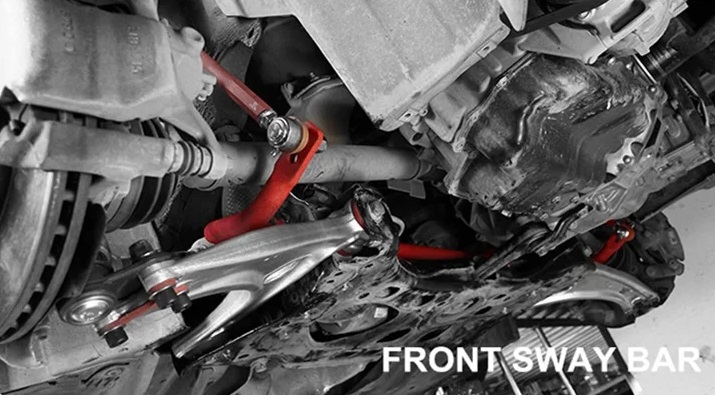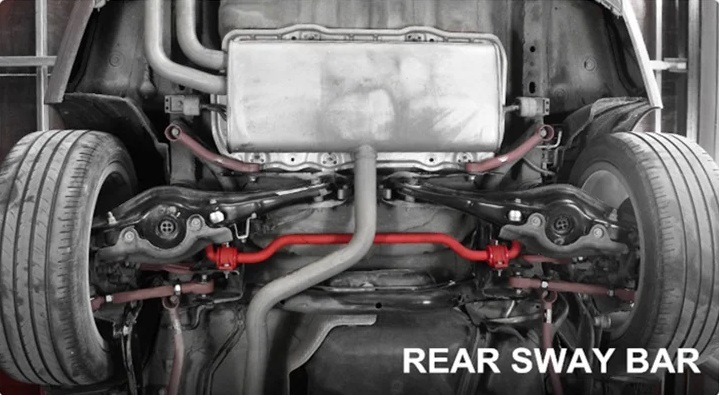Anti Roll Bars

Anti-roll bars or sway bars or stabilizer bars are popular with tuners and indispensable in racing. What good are these things, why might you need them yourself and what are the disadvantages?
We can be brief about the usefulness of anti-roll bars: the name says it all. These bars reduce body roll and that is useful when, for example, a car takes a bend (at higher speed). The weight shift will place most of the pressure on the outer wheels. Not cool, because you want to spread the load over both tires. In the worst case, for example, you lift the front wheel on the inside of the bend. You don't want that, because a tire hanging in the air naturally provides no grip at all.
Some things became painfully clear during qualifying for the Singapore GP yesterday. The roll bar on the right rear of Vettel's Ferrari gave way to Maarten, causing the left front wheel to dangle helplessly in the air during left turns. End of qualifying for the four-time champion, a good reason for us to dive in.

What are anti roll bars?
Sway bars are rods (or tubes, they can also be hollow) that are mounted, for example, on the underside of the struts or on the lower wishbones. These bars connect both struts on one axle. Furthermore, these stabilizer bars are attached to the chassis in such a way that they can only rotate around their longitudinal axis.
The moment one wheel is pressed onto the axle in the suspension (a bend, a bump, an iPhone), the sway bar is lifted up on one side. At the same time, the stabilizer bar rotates around its longitudinal axis, rises on the other side and so the wheel on that side (in bends: the inner wheel) is also pressed slightly upwards into the suspension. As a result, the difference between the two wheels is reduced, the car rolls less on its longitudinal axis and the pressure is better distributed over both tires.

Please note: the stiffness of the roll bar is crucial. The stiffer this twisting rod is, the more the difference between the two wheels is eliminated. A compromise will have to be found (as is always the case when it comes to tuning a car).
The difference between front and rear must also be taken into account. Installing a (stiffer) anti-roll bar at the front can help prevent oversteer. A (stiffer) rear sway bar can do the same in eliminating understeer. As a refresher: with understeer, the front axle loses grip first, causing the car to want to go straight when cornering. In the case of oversteer, the rear tires lose grip sooner than the front tires, causing the rear of the car to overtake the front and the car to actually turn “too far” into the corner.

Possible disadvantages of anti-roll bars
Sway bars are also used in rallying and these cars have to do their thing on all kinds of surfaces. Based on this we can nicely explain the possible disadvantages of (too stiff) stabilizer bars. On bumpy stages the anti-roll bars are adjusted less stiff. In the bends we will help slightly to prevent body roll, but ultimately it is important that both wheels on an axle can move independently of each other.
The stiffest stabilizer bars are therefore used for asphalt tests, which (unless they take place in Belgium, just kidding) are a lot less bumpy. If those stiff sway bars were used on mud trials and on unpaved roads, one wheel on an axle might be lifted by the stabilizer bar because the other wheel encounters a bump or a stone, for example. Still a lifted wheel = unfavorable and therefore undesirable.
This does not only apply to bumps. Overly stiff sway bars can also cause the inside wheel on an axle to lift in a turn as well.

Active systems
Every disadvantage has its advantage (TM) and for car manufacturers it is of course the ultimate challenge to devise systems that find the perfect compromise between advantage and disadvantage. This can also be achieved in this case using active systems. An example of this is Active Body Control from Mercedes. ABC is actually a replacement for the anti-roll bar. Various things (body roll, lateral acceleration, etc.) are measured using sensors and the computer system then ensures that the movements of both wheels on an axle are in balance. This system can be compared to torque vectoring, which takes over the role of the mechanical limited slip differential in a similar way through small braking interventions that are controlled by the computer.













































